Not Your Average Box: How Industrial Crating Has Evolved
When most people picture a shipping crate, they imagine a heavy wooden box nailed together to keep goods secure on their journey. For decades, that image wasn’t far off. Crating was once a straightforward, one-size-fits-all solution: reliable enough for basic freight but limited in its ability to protect complex or high-value cargo.
Today, the industry looks drastically different. Industrial crating has evolved into a field that blends engineering, design, and sustainability.
At Reid Packaging, we’ve seen firsthand how custom shipping crates have gone from simple containers to highly engineered packaging solutions built for the demands of a global economy.
From Wooden Boxes to Engineered Protection
The early days of crating focused purely on durability. Thick lumber and heavy nails kept products intact, but these boxes were bulky, hard to handle, and often overbuilt. As industries like aerospace, medical devices, and advanced manufacturing grew, the old model stopped working. Sensitive equipment requires more than brute force—it needs precision.
That’s where engineering changed the game. Modern custom shipping crates are purpose-built, accounting for weight distribution, vibration, moisture, and even climate conditions. Foam interiors, shock-absorbing bases, and tailored bracing systems now make it possible to ship fragile or oversized machinery across the world with confidence.
Sustainability Takes the Lead
Another major shift is how materials are sourced, used, and reused. Companies no longer want crates that serve their purpose once and head straight to the landfill. That’s why recycled packaging materials, reusable components, and refurbishment capabilities are now central to crating design. By integrating plywood alternatives, recyclable corrugated panels, and modular fasteners, we help reduce waste while still ensuring protection. Learn more about Reid Packaging’s sustainability commitment.
Sustainability isn’t just about materials—it’s also about efficiency. Engineered packaging solutions are designed to minimize space and materials used, which can cut shipping costs and reduce carbon emissions. A crate that stacks efficiently or breaks down for reuse has an impact that goes well beyond the shipping floor. Learn more about engineering for sustainability from Reid’s parent company TransPak: engineered packaging solutions.
What Sets Reid Packaging Apart
At Reid Packaging, we don’t build average boxes. Every crate is tailored to the unique demands of what’s inside. Whether it’s a delicate medical device or a piece of heavy machinery, our engineers design with three priorities in mind: protection, efficiency, and sustainability.
- Protection: Advanced cushioning, bracing, and ISPM-15 compliant materials safeguard goods through every mode of transport.
- Efficiency: Optimized sizing and weight distribution lower costs and streamline handling.
- Sustainability: From recycled packaging materials to reusable designs, we’re committed to reducing environmental impact without compromising strength.
The Future of Crating
Industrial crating has come a long way from its rough lumber origins. Today, it’s an engineered discipline that blends science, sustainability, and smart design. For businesses shipping high-value equipment, that evolution means greater security, reduced costs, and a greener footprint.At Reid Packaging, we’re proud to lead that evolution—proving that the right crate is never just a box. Get in touch to discuss your job with us.

